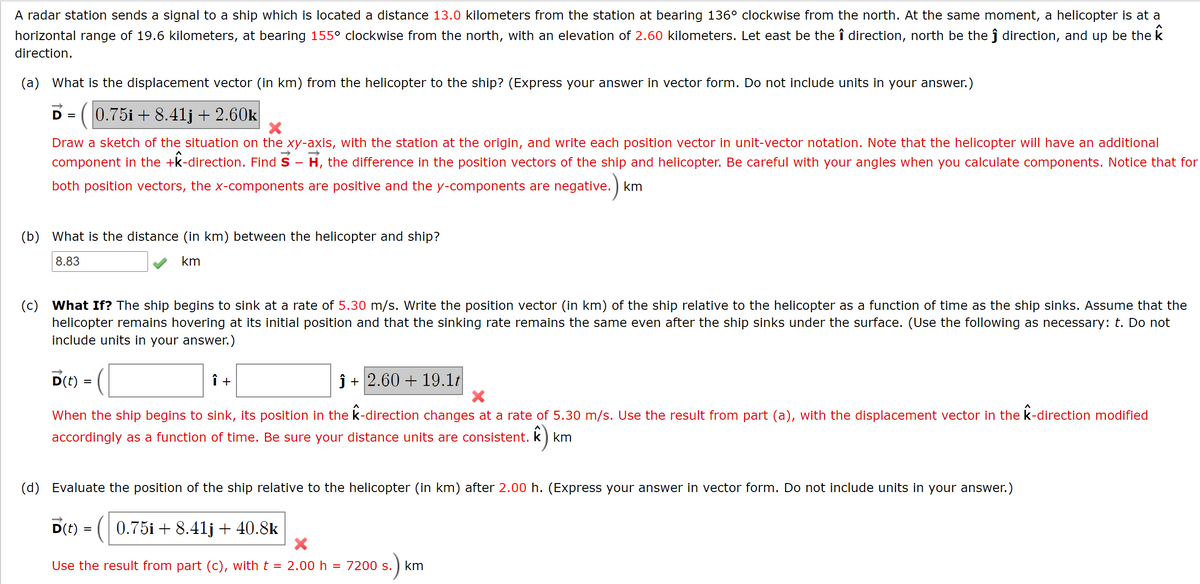A radar station sends a signal to a ship which is located a distance 13.0 kilometers from the station at bearing 136° clocKwise from the north. At the same moment, a helicopter horizontal range of 19.6 kilometers, at bearing 155° clockwise from the north, with an elevation of 2.60 kilometers. Let east be the î direction, north be the j direction, and up be the k direction. (a) What is the displacement vector (in km) from the helicopter to the ship? (Express your answer in vector form. Do not include units in your answer.)
A radar station sends a signal to a ship which is located a distance 13.0 kilometers from the station at bearing 136° clocKwise from the north. At the same moment, a helicopter horizontal range of 19.6 kilometers, at bearing 155° clockwise from the north, with an elevation of 2.60 kilometers. Let east be the î direction, north be the j direction, and up be the k direction. (a) What is the displacement vector (in km) from the helicopter to the ship? (Express your answer in vector form. Do not include units in your answer.)
Principles of Physics: A Calculus-Based Text
5th Edition
ISBN:9781133104261
Author:Raymond A. Serway, John W. Jewett
Publisher:Raymond A. Serway, John W. Jewett
Chapter1: Introduction And Vectors
Section: Chapter Questions
Problem 35P
Related questions
Question
Please help! Thank you so much.

Transcribed Image Text:A radar station sends a signal to a ship which is located a distance 13.0 kilometers from the station at bearing 136° clockwise from the north. At the same moment, a helicopter is at a
horizontal range of 19.6 kilometers, at bearing 155° clockwise from the north, with an elevation of 2.60 kilometers. Let east be the î direction, north be the ĵ direction, and up be the k
direction.
(a) What is the displacement vector (in km) from the helicopter to the ship? (Express your answer in vector form. Do not include units in your answer.)
D = (0.75i + 8.41j + 2.60k
Draw a sketch of the situation on the xy-axis, with the station at the origin, and write each position vector in unit-vector notation. Note that the helicopter will have an additional
component in the +k-direction. Find S - H, the difference in the position vectors of the ship and helicopter. Be careful with your angles when you calculate components. Notice that for
both position vectors, the x-components are positive and the y-components are negative. ) km
(b) What is the distance (in km) between the helicopter and ship?
8.83
km
(c) What If? The ship begins to sink at a rate of 5.30 m/s. Write the position vector (in km) of the ship relative to the helicopter as a function of time as the ship sinks. Assume that the
helicopter remains hovering at its initial position and that the sinking rate remains the same even after the ship sinks under the surface. (Use the following as necessary: t. Do not
include units in your answer.)
D(t)
î +
ĵ + 2.60 + 19.1t
When the ship begins to sink, its position in the k-direction changes at a rate of 5.30 m/s. Use the result from part (a), with the displacement vector in the k-direction modified
accordingly as a function of time. Be sure your distance units are consistent. k) km
(3
(d) Evaluate the position of the ship relative to the helicopter (in km) after 2.00 h. (Express your answer in vector form. Do not include units in your answer.)
D(t) = ( 0.75i + 8.41j + 40.8k
Use the result from part (c), with t = 2.00 h
7200 s.
km
Expert Solution
This question has been solved!
Explore an expertly crafted, step-by-step solution for a thorough understanding of key concepts.
This is a popular solution!
Trending now
This is a popular solution!
Step by step
Solved in 3 steps with 1 images

Knowledge Booster
Learn more about
Need a deep-dive on the concept behind this application? Look no further. Learn more about this topic, physics and related others by exploring similar questions and additional content below.Recommended textbooks for you

Principles of Physics: A Calculus-Based Text
Physics
ISBN:
9781133104261
Author:
Raymond A. Serway, John W. Jewett
Publisher:
Cengage Learning

University Physics Volume 1
Physics
ISBN:
9781938168277
Author:
William Moebs, Samuel J. Ling, Jeff Sanny
Publisher:
OpenStax - Rice University

Glencoe Physics: Principles and Problems, Student…
Physics
ISBN:
9780078807213
Author:
Paul W. Zitzewitz
Publisher:
Glencoe/McGraw-Hill

Principles of Physics: A Calculus-Based Text
Physics
ISBN:
9781133104261
Author:
Raymond A. Serway, John W. Jewett
Publisher:
Cengage Learning

University Physics Volume 1
Physics
ISBN:
9781938168277
Author:
William Moebs, Samuel J. Ling, Jeff Sanny
Publisher:
OpenStax - Rice University

Glencoe Physics: Principles and Problems, Student…
Physics
ISBN:
9780078807213
Author:
Paul W. Zitzewitz
Publisher:
Glencoe/McGraw-Hill

College Physics
Physics
ISBN:
9781285737027
Author:
Raymond A. Serway, Chris Vuille
Publisher:
Cengage Learning

Classical Dynamics of Particles and Systems
Physics
ISBN:
9780534408961
Author:
Stephen T. Thornton, Jerry B. Marion
Publisher:
Cengage Learning